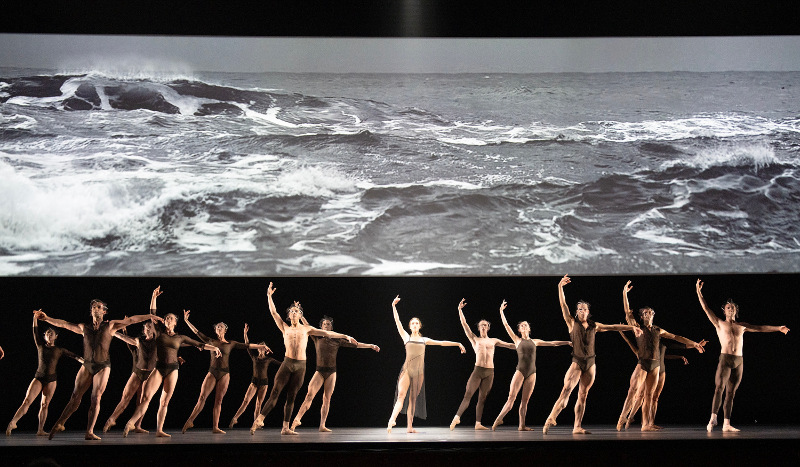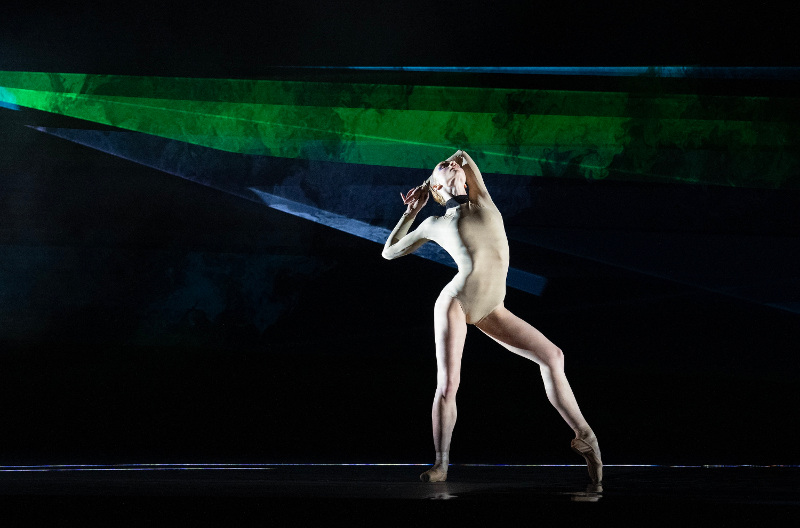
American Ballet Theatre, now in its eighth decade, reclaims its mantle as a font of top international repertoire with “Woolf Works,” a theatrical evocation of three novellas written by the most poetic of 20th century authors, Virginia Woolf. The ambitious full-evening ballet has contemporary-classical choreography by Briton Wayne McGregor to a moody and rambunctious original score by Max Richter.
The work, a 2016 commission by the Royal Ballet, put down roots in U.S. soil this past weekend under the aegis of ABT’s new artistic director Susan Jaffe in its American premiere at Segerstrom Center for the Arts. “Woolf Works” is headed for a run at New York’s Metropolitan Opera House this summer, where, one prognosticates, this thought-provoking, deeply engaging and highly visual (in this realm, “Woolf Works” is gorgeous) dance spectacle will find a keen audience.
Called by its creator/choreographer a “triptych” for its joining of three discrete mini-ballets, “Woolf Works” seeks to meld the feelings and ideas of the written word with the physical language of classical ballet. Much aided by striking if not spectacular production design, McGregor spins an admirable, wide-ranging array of choreography that gives the ABT dancers the platform to evince strong acting skills as well as the room to inhabit, as it were, their humanity. This, in our view, is a good thing.

Of ABT’s several casts on offer, we saw principals Devon Teuscher and James Whiteside in leading roles; both were superb, particularly the long-and-lean Teuscher in what is essentially a woman’s ballet.

If conventional wisdom holds that making a movie about the life and work of a writer is a difficult task, then McGregor and his collaborators had their work cut out doing so in a ballet. The written word does appear in “Woolf Works” in scrims; in the sound of a quill pen scratching a paper’s surface; and in Woolf’s own recorded voice heard in voice-overs. But the ballet is predominantly steeped in conceptual interpretations of Mrs. Dalloway (1925), Orlando (1928), and The Waves (1931). Each mini-ballet has a discrete look and feel of choreography, music, production design, costume design, hair/make up, soundscape, dramaturgy, and lighting. But the trio shares a familial DNA; one grounded in Woolf’s nervous-making tonality that juxtaposes a deep joy in nature and human relations with a terrible foreboding, a sense of a fearsome fate. Of McGregor’s choreography, I most enjoyed the muted elegance of his very classical dance palette in parts one and three. Part one, in its beauty and minimalism brought the constrained emotionalism of Antony Tudor to mind. In “Woolf Work”‘s middle section, to thrusting, driving music, the dancers — dressed in gold glow-wear as the bisexual Orlando, with pie-plate tutus — looked uncomfortable if not wobbly and under rehearsed. Is the smoke device absolutely necessary? It seemed to cause one dancer’s slide to the floor.

Seen above, a sly choreographic trick that worked seamlessly; a simple scenario in which a stageful of dancers present a single leg to the front, finished by a strongly pointed foot, and then the tracing of that foot on the ground, in a semicircle, to the rear. This the basic balletic rond-de-jambe. Change direction, rinse and repeat. It unifies disparate bodies and in its repetition, deconstruction, and unison undertaking, evokes the kinds of language experimentation Woolf herself manifest in her texts. Orange County’s ballet-savvy audience gave a kind of solemn respect to this extenuated sequence, along with other headier atmospherics, for example, the amazing laser-beam lighting by Lucy Carter, which, over our heads in the theater’s airspace inserted white 3-D cross-hatching. It wasn’t that there was an “adult in the room”; rather, it felt like a roomful of adults, something that in our day and age, in a shared public space, felt like a rare pleasure.
Costumes by Moritz Junge give dance capability to the high-necked, long-sleeved Edwardian look of the era —heads up, this is a ballet for women — the simple addition of a cardigan sweater which evokes wartime, and the silhouette of a dough-boy similarly wrenches the heart. Massive mobile set pieces–three-dimensional frames, literally framed and gave distance to characters as they rotated in and out of our focus. The sound of church bells evoked the evolution into a modern age in which religious precepts were being undone by the indecencies of war.

The dancers nearly glided through all this pithy material, putting to great use their state-of-the art ballet technique and imbibing what is essentially British content. But any cultural disparity seemed to melt away as the ABT dancers brought deep passion to their performances. One sensed a big, group sigh of relief (my projection here) from dancers (can it be?) weary (is this possible?) of being transmuted into acrobatic robots (much by the likes of Wayne McGregor in earlier choreographic days, and, ahem, in that second act) when given the opportunity to dance as actual human beings conveying identifiable human emotions. Not for nothing, ABT is a house of Tudor and de Mille. Even the company’s repertoire of white ballets produces acting dancers. So, in essence, while “Woolf Works” travels back in time, it is a foray back to ABT’s future.
The choreographer, Wayne McGregor, is seen working with two of ABT’s principal dancers, below.

photo credit: Ravi Deepres
Dance critic Debra Levine is founder/editor/publisher of arts●meme.

Be SURE to let us know how you like it, if you do!
Hope to see this at the Met this summer!